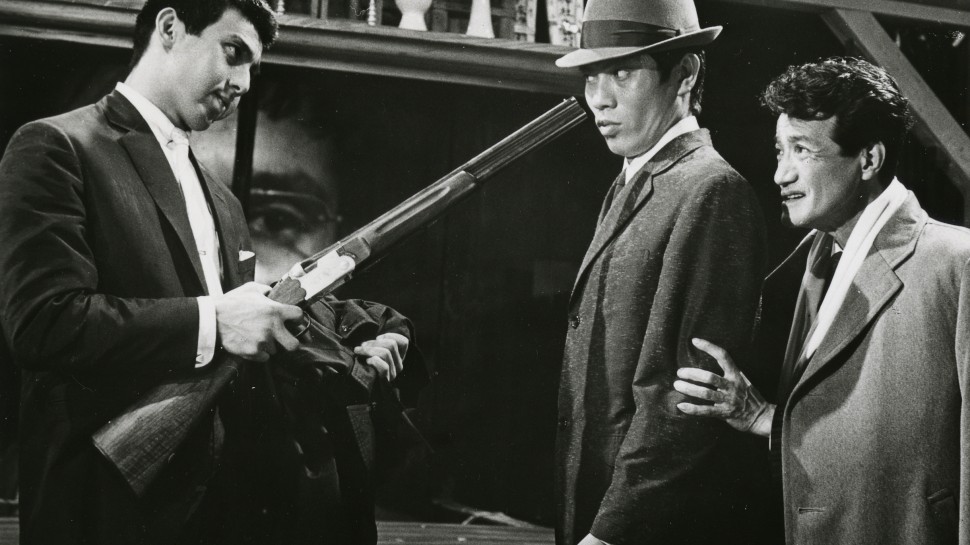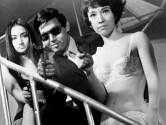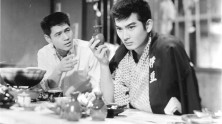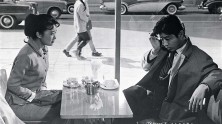
Time and Place are Nonsense!
The Cinema According to Seijun Suzuki
Struck by an Allied aircraft during the Asia-Pacific War and disinvested of any remaining macho illusions of combat, Seijun Suzuki, then Pvt. Seitaro Suzuki, was reportedly rescued in the ocean somewhere outside the Philippines during the waning days of battle in the mid-1940s. It is said that he floated for days before being found, though his next destination—the hollowed-out wreckage of postwar Japan—would hardly be more hospitable. Desperate for work and vaguely recalling inspiring pre-war viewings of the early Lilian Harvey-starring German musical Congress Dances (1931) and the Japanese period film The Last Days of Edo (1941), Suzuki took the advice of a friend and applied to the Kamakura Academy, a feeder institution for major studios like Shochiku and Nikkatsu.
There may be more mysterious origin stories to be found within the history of world cinema, but likely few that seem so strangely indicative of the career that followed. Suzuki’s biography is that of a vagrant, a man who moved from one temporary settlement to another, seemingly always on the brink of isolation. His films, in turn, pop with a vitality that suggests an awareness of that fundamental impermanence, as though his consciousness of time’s passing and life’s precariousness naturally produced a compulsion to make the most of any given limitation. And as a B-director working within the rigidly hierarchical mainstream industry of Japan, Suzuki knew a lot about limitations.
After a short stint at Shochiku, where he assisted on a number of melodramas, Suzuki migrated along with Shohei Imamura to Nikkatsu, then rebranding, after a ten-year hiatus, as an ostensibly edgy genre outfit with an eye toward the youth market. His first gigs were as an apprentice to veteran Hiroshi Noguchi, whose eventual helming of a script written by Suzuki gave the studio’s executives the confidence to audition their fledgling talent in the director’s chair—though only on lower-budgeted program pictures that would play alongside A-films. Most of these early efforts, which seldom ran over an hour, have been forgotten, and none are available on home video, though their titles alone, fortuitously or not, suggest a sensibility in training. Satan’s Town (1956), for instance, might be the jokey name for the kill-or-be-killed alternate universe in which all Suzuki movies take place, while Pure Emotions of the Sea (1956) seems a premonition of a memorable instance of oceanic rear projection in 1964’s extravagant melodrama The Call of Blood.
Whatever their merits, these projects paved the way for Suzuki’s stable position in the Nikkatsu Rolodex, which he maintained for a decade at a pace of three or four films a year. (“No-name directors like me had zero time, so I had no choice but to stay up all night and never go home,” reflects Suzuki on the job requirements.) It was in this role that he developed the reputation he most popularly holds today—that is, as a purveyor of generically plotted yakuza films marked by an ever-increasing stylistic lunacy. Nikkatsu’s stock-in-trade at the time was mukokuseki akushon (“no-nationality action,” or “borderless action”), a subgenre that sought to downplay cultural, geographic and temporal specificity in order to better target global audiences, and in many ways Suzuki proved an ideal chameleon for the job. His yakuza films pull as much from American movie lore as they do from sources within his own country’s cultural legacy, staging chain-smoking hired killers and saucy femme fatales within Kabuki-like tableaux and familiar Japanese storytelling contexts, meanwhile setting it all to fizzy pop tunes. This fluency with the new Westernized market hit its zenith in 1966’s Tokyo Drifter, a hip slice of gangland warfare that treats urban Japan like neon-soaked Las Vegas, not to mention a cult object whose peculiar glow can be felt strongly in the work of Suzuki disciples Jim Jarmusch and Quentin Tarantino.
Suzuki recaps the order of business at Nikkatsu thusly: “The studio came to me with a script and asked me to make it. But whatever I cooked up after that was up to me.” For him, the role of the B-director was a double-edged sword: limited resources meant both less on-set supervision and more compromise. Like any shrewd workman, though, Suzuki was at his best when turning his limitations into strengths. Crowded shooting schedules encouraged impromptu technical experimentation, such as the in-camera superimpositions that became a unique Suzukian flourish when depicting internal states. Meanwhile, with the assistance of longtime production design collaborator Takeo Kimura, tawdry studio-built sets were embraced for their flimsiness, and it became a trend for Suzuki to disassemble them in the climaxes of his films so that his characters were suddenly adrift in two-dimensional color fields. In repeatedly calling attention to the artificiality of the medium and the construction of the narrative world, Suzuki’s form began to mirror his governing conception of society as a set of meaningless codes whose flimsy sense of order could easily be thrown into chaos.
This worldview infused all of Suzuki’s output, which included not just crime films but war melodramas, absurdist comedies and seishun eiga (youth pictures), and it reached its most powerful expression in his “Flesh Trilogy” (1964’s Gate of Flesh, 1965’s Story of a Prostitute, and 1966’s Carmen from Kawachi), a series of button-pushing adaptations of popular Taijiro Tamura novels that together constitute the filmmaker’s crowning achievement at Nikkatsu. Despite their tricky gender politics, frank depictions of sex work, and subversive attitudes toward the Japanese military, however, these films were not the ones that finally broke the studio’s patience. That honor went to Branded to Kill, a surreal noir sketch starring the director’s jumbo-cheeked alter ego Jo Shishido that took Suzuki’s often-palpable disinterest in his pulp material to new extremes. The film stimulated a firing that was the culmination of a string of warnings handed down to Suzuki by Nikkatsu president Kyusaku Hori since 1963’s Youth of the Beast, and it so inflamed Hori in its “unintelligible” excesses that he suspended a thirty-seven-film retrospective in development at the time. Suzuki would later win a court settlement against Hori’s actions and regain some of his dignity, though by that point his contract potential was more or less dead in the water.
Ten years of television features and corporate commissions followed before Suzuki was welcomed back into the theatrical film business with a smattering of works for smaller production companies, most of which satiated certain appetites left unfulfilled by his day job years earlier. It was in films like 1980’s Zigeunerweisen, 1981’s Kagero-za, and 1991’s Yumeji, for instance, that he was finally able to indulge a longtime fascination with the uncanny, while 2001’s Pistol Opera, billed as a spiritual sequel to Branded to Kill, afforded him an unprecedented opportunity to push his action filmmaking eccentricities into overdrive on the dime of a sympathetic backer.
But to imply that Suzuki was finally self-actualized as an artist once liberated from the clutches of the commercially safe Nikkatsu would be a patent mistruth. Not only did the eternally pragmatic and humble director embrace his responsibilities as an entertainer-for-hire (“I didn’t feel like rebelling against the system…I was just trying to grind out program pictures,” he submits), but it might also be argued that the industrial context within which Suzuki worked provided the walls he needed to push against in developing his filmmaking voice. A restless, tinkering innovator at heart who’d jumped from one lackluster or hostile environment to another during his youth, Suzuki was overdue for a sturdy support system to give shape to his talents, and it’s thanks to Nikkatsu’s leap of faith that a Japanese cinema seeking a new identity after the war was energized by one of its zaniest visionaries. – Carson Lund




















